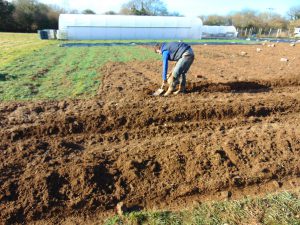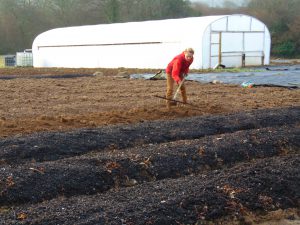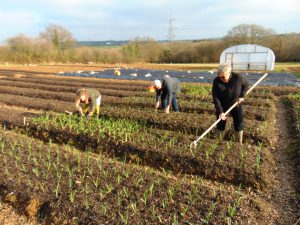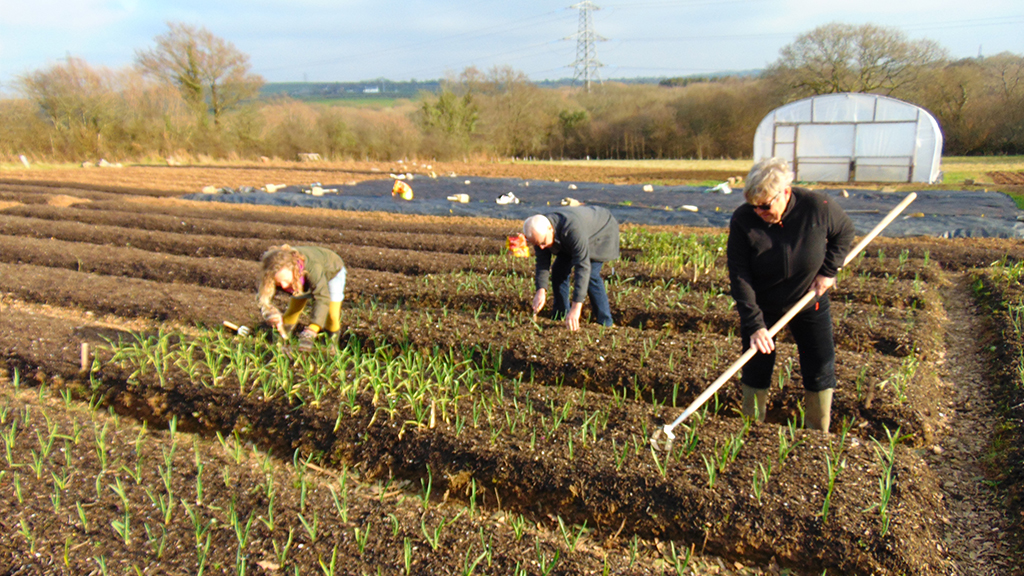All winter we’ve been hard at work creating more than 60 raised beds, and they aren’t finished yet! When we bought the patch of ground that is now the Real Food Garden it was scrubby pasture. Prior to that it had been a potato field and from the huge numbers of flint blades we find all over the garden I’d say that people were eeking out a living here in a not dissimilar way thousands of years ago.
We started converting our fairly unproductive space into a no-dig market garden last July when we had the grass ploughed and rotavated several times to give us a good chance of beating the docks, creeping buttercup and dandelions. A conventional grower would use herbicides to clear the soil of unwanted plants (weeds), an organic grower uses mechanical means, usually some form of rotavation at least once a year, sometimes as many as six passes churning the soil up.
At the Real Food Garden we are most unconventional so no herbicides and no churning the soil either. The beds we are slogging away on at the moment are permanent. The path system is permanent and no machinery will disturb the soil in our growing area again. This will give all the soil life the chance to develop into a healthy ecosystem, full of fungi, bacteria, invertebrates all thriving and creating a resilient soil for our crops.


We have a lovely clay soil which is naturally full of nutrients. However heavy machinery could render our land almost lifeless through compaction. By squeezing all the air pockets out of the soil it becomes a hard, solid layer which water runs off or pools on, no good for growing veg at all. By creating permanent raised beds we only cause compaction in the paths and less than modern machinery would create, plus we improve the air holding capacity of the soil by adding organic matter.
We add about a wheel barrowful of green waste compost for every 1.2m of bed, it ends up being less than 5cm of compost covering the bed. This has huge benefits in weed suppression and Charles Dowding swears by adding lots of green waste compost (made from the garden waste sent to recycling centres). We are already finding it a good weed suppressor, excellent for the soil structure and a great way to prevent us disturbing the soil life beneath.


Because we are nurturing our soil in this way we are less affected by wet springs which would prevent many from ploughing and rotavating their soil ready for sowing. We have seen some marvellous market gardens based on this system (and some fantastic conventional market gardens too!). The most well known is Charles Dowding’s site and published work. Charles has found he gets greater yields from raised beds (we are hoping this will work for us too!) and needs very little in the way of equipment by using this system. This is fantastic news for new entrants into growing like Chloe and I who have neither inherited any capital or machinery nor wish to perpetuate an agriculture which relies on fossil fuels.
Unlike lots of raised beds ours don’t have sides, in our experience having open and sloping sides increases the ease of working and leaving less hidey holes for slugs. We’ve seen this work well at Primrose Organic Farm, Gold Hill Farm as well as at Charles’s Dowding’s small but very productive site. We are experimenting with different path surfaces including our home-made woodchip, compost and cardboard, we’ll keep you posted!


Some critics of Dowding’s method of using large amounts of green waste compost claim it is not a system that can be scaled up. We are using a medium amount of green waste compost to start our beds. We get it from The Green Waste Company just a couple of miles up the road. So it is a fairly renewable resource which is plentiful (if not rather expensive). None-the-less we are wary of becoming dependent on importing all our nutrients for economic and environmental reasons. So we are creating the beds with varying proportions of compost to explore how crops respond and how we can foster healthy soils in other ways. We also use well rotted horse manure and compost teas made from our own comfrey and nettles. Additionally we make compost and leaf mulch to use on our perennial crops in an attempt to cycle as much of or nutrients and organic matter as possible.
So whilst it is extremely hard going creating our 60 permanent beds I feel confident that we will benefit from a lovely fluffy tilth, teaming with life and rich in nutrients and organic matter, all to be reflected in our delicious veg!

